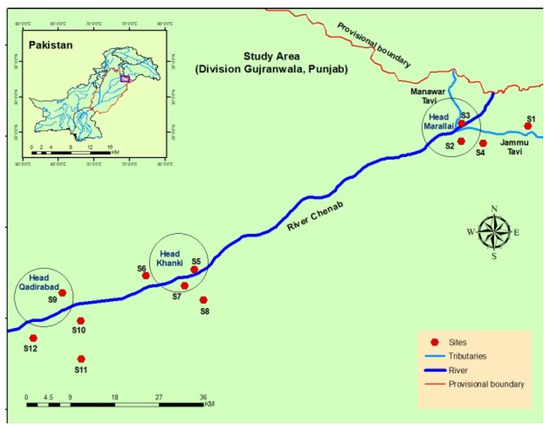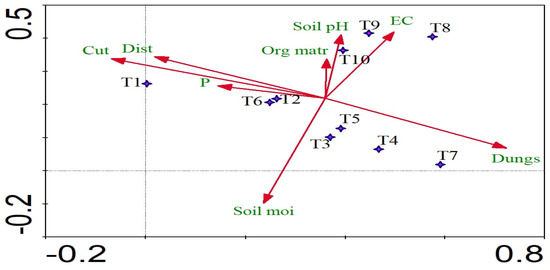Abstract
This study focused on the impact assessment of the wild flora and environmental gradients encompassed by the River Chenab headworks using quantitative ecological indices. Quadrats of 1 × 1, 5 × 5 and 10 × 10 m2 sizes were used for vegetation. Considering environmental data, grazing and anthropogenic effects, soil analysis based on different physical and chemical properties was studied. The relationship between different sites and their surroundings was analyzed by Canonical and Detrended Correspondence Analysis. Similarity indices were revealed through the use of a heat map and dendrogram. As many as 130 plant species, 60 families, comprising 104 species of dicots, 17 monocots, 7 pteridophytes and 2 species of bryophytes were recorded. Different soil properties including organic matter, soil moisture and soil pH affect the vegetation on different sites. Anthropogenic activities such as construction, fishing and animal grazing were the main threats for vegetation that need to be restricted strategically to conserve surrounding vegetation.
1. Introduction
The distribution pattern of plant species is affected by both natural as well as anthropogenic factors such as habitat characteristics, climate change, topography, hydrology geology, species migration and soil type [1]. These changes bring remarkable variations in the environment and climate of different habitats and maintain the ecological elements that have a crucial role in the distribution pattern of species diversity [2]. The evolution, origination, diversification and distribution of particular flora are determined by its phytogeographic exploration. Understanding the floristic inventory and distribution of vegetation is very significant for the conservation of biodiversity [3,4,5]. The vegetation along the catchment area of rivers is known as riparian vegetation which is the best indicator of ecological stability [6,7]. It is the buffer zone between the terrestrial and aquatic ecosystems.
The riverine ecosystems provide services such as habitats for terrestrial and aquatic organisms, protection of water quality, storing of water, facilitating organic material and diluting the heavy metal concentration in plants. The riparian vegetation is substantially affected by biotic and abiotic disasters [8]. The deterioration in the flora of an area is typically disturbed due to over exploitation which commonly remains faster than the level of species regeneration and natural restoration. This study was designed to analyze riverine ecosystems around three headworks, i.e., Head Maralla, Head Khanki and Head Qadirabad, to consider how they affect the diversity of wild flora and its interaction with environmental variables.
2. Materials and Methods
River Chenab originates from Himachal Pardesh, India and runs down 960 KM in Pakistan. The main study sites were Head Maralla with a 2816 ha wetland area, Head Khanki with 12 ha and Head Qadirabad which comprises a 1620 ha area. Figure 1 shows the location of the study area.

Figure 1.
Location of study area (Head Maralla, Head Khanki and Head Qadirabad) at River Chenab.
2.1. Selection of Sampling Sites
Head Maralla is situated in District Sialkot. Head Khanki is situated in Gujranwala and Head Qadirabad is situated in Mandibahudin. The field work was carried out in summer 2021 using the quadrat method. Quantitative attributes such as density, frequency and abundance of each vascular plant species were measured. The study area of about 85 km was divided into 10 sampling sites with four quadrats.
2.2. Soil Analysis
Soil samples were collected from different selected sites and different indicators such as pH, soil moisture, organic matter, soil saturation, available potassium and phosphorus were studied.
2.3. Data Analysis
To determine the relationship between plant species and their various environmental variables and similarity indices, CANOCO version 4.5 software was used for the DCA (Detrended Corresponding Analysis), CCA (Canonical Corresponding analysis), heat map and dendrogram.
3. Results
In this research, we have documented 130 plant species belong to 60 families and 105 genera, in which dicot families were 47, genera 85 and plant species 97 (Table 1). From a particular area, the main source and the most useful botanical information are its floristic checklists. Floristic composition is a good floristic marker, because any kind of variation in different environments shows the existence of different environmental factors that lead to inter- and intra-specific diversity [9].

Table 1.
Summary of floristic diversity of River Chenab (Head Maralla to Head Qadirabad).
The distribution of sites investigated using DCA tools proved clustering results and also showed that different anthropogenic variables such as animal dungs, nearby construction sites and cut marks have a significant correlation with the study sites. We have assessed the relationship between environmental variables at the sites (Figure 2). CCA by using anthropogenic predictors such as cut marks, animal dung and distance from the nearby construction sites was analyzed (Figure 3). Some previous studies have determined the anthropogenic effect on the other side of the country (Sarwar and Qaiser 2012).

Figure 2.
DCA between different sites and environmental variables.

Figure 3.
CCA between different sites and environmental variables.
4. Discussion
Different environmental variables had a significant effect on the vegetation [10]. Organic matter, soil saturation and soil pH had the most significant impact on the vegetation. Therefore, we demonstrate that there is a direct relationship between vegetation and environmental variables [11]. We also conclude that the area is a hub for various unique species such as Adhatoda vesica, Salvinia spp. and Tamarix aphylla. Therefore, considering the environmental factors is significant for implementing management strategies and plant conservation in the riverine area especially near the headworks.
Author Contributions
Both authors contributed equally. All authors have read and agreed to the published version of the manuscript.
Data Availability Statement
All of the relevant data is already included.
References
- Teixeira, A.M.C.; Pinto, J.R.R.; Amaral, A.G.; Munhoz, C.B.R. Angiosperm species of “Cerrado” sensu stricto in Terra Ronca State Park, Brazil: Floristics, phytogeography and conservation. Braz. J. Bot. 2017, 40, 225–234. [Google Scholar] [CrossRef]
- Mota, G.S.; Luz, G.R.; Mota, N.M.; Coutinho, E.S.; Veloso, M.D.D.M.; Fernandes, G.W.; Nunes, Y.R.F. Changes in species composition, vegetation structure, and life forms along an altitudinal gradient of rupestrian grasslands in south-eastern Brazil. Flora 2018, 238, 32–42. [Google Scholar] [CrossRef]
- Harris, D.J.; Armstrong, K.E.; Walters, G.M.; Wilks, C.; Mouandza Mbembo, J.-C.; Niangadouma, R.; Wieringa, J.J.; Breteler, F.J. Phytogeographical analysis and checklist of the vascular plants of Loango National Park, Gabon. Plant Ecol. Evol. 2012, 145, 242–257. [Google Scholar] [CrossRef][Green Version]
- Moradi, G.; Mohadjer, M.R.M.; Amiri, G.Z.; Shirvany, A.; Zargham, N. Life form and geographical distribution of plants in Posthband region, Khonj, Fars Province, Iran. J. For. Res. 2010, 21, 201–206. [Google Scholar] [CrossRef]
- Pourrezaei, J.; Khajeddin, S.J.; Karimzadeh, H.R.; Vahabi, M.R.; Mozaffarian, V.A.; Esfahani, M.T. Phytogeographical distribution of roadside flora along the plain to mountainous natural areas (Northern Khorasan Province, Iran). Flora 2017, 234, 92–105. [Google Scholar] [CrossRef]
- Pertiwi, N.; Taufieq, N.A.S. The Diversity of Trees Vegetation at Around The Lawo River, South Sulawesi, Indonesia. J. Phys. 2019, 1244, 012008. [Google Scholar] [CrossRef]
- Meragiaw, M.; Woldu, Z.; Martinsen, V.; Singh, B.R. Woody species composition and diversity of vegetation along the Walga River, Southwestern Ethiopia. PLoS ONE 2018, 13, e0204733. [Google Scholar] [CrossRef] [PubMed]
- Sunil, C.; Somashekar, R.K.; Nagaraja, B.C. Diversity and composition of vegetation across forest and agroecosystem landscapes of river Cauvery, southern India. Trop. Ecol. 2016, 57, 343–354. [Google Scholar]
- Ahmad, S.S.; Nawaz, M.; Khan, S.M. Evaluating the effects of Soil pH and moisture on the plant species of changa Manga forest using Van Dobben Circles. Middle-East J. Sci. Res. 2013, 17, 1405–1411. [Google Scholar]
- Iqbal, M.S.; Dar, U.M.; Akbar, M.; Khalil, T.; Arshad, N.; Hussain, S.A.; Munir, S.; Ali, M.A. Quantitative analysis of Ethnobotany and common remedies associated with threatened flora of Gujranwala region, Punjab, Pakistan, elaborated through quantitative indices. Appl. Ecol. Environ. Res. 2020, 18, 7953–7979. [Google Scholar] [CrossRef]
- Iqbal, M.S.; Ahmad, K.S.; Ali, M.A.; Akbar, M.; Mehmood, A.; Nawaz, F.; Bussmann, R.W. An ethnobotanical study of wetland flora of Head Maralla Punjab Pakistan. PLoS ONE 2021, 16, e0258167. [Google Scholar] [CrossRef]
Publisher’s Note: MDPI stays neutral with regard to jurisdictional claims in published maps and institutional affiliations. |
© 2021 by the authors. Licensee MDPI, Basel, Switzerland. This article is an open access article distributed under the terms and conditions of the Creative Commons Attribution (CC BY) license (https://creativecommons.org/licenses/by/4.0/).